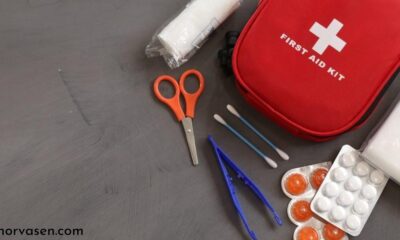Business
Out of the Box Marketing Ideas to Drive Property Buyers to Your Listings

When you’re trying to sell a home in a competitive market, every marketing effort matters. But do you know what to try? From tapping into local influencers to boosting your staging game, the creative options are endless.
Keep reading to discover marketing ideas that will drive property buyers to your listings!
Upgrade Your Visuals
Good visuals can help home listings emerge from the pack. That means focusing on stronger photography and video footage. If photography isn’t your forte, you may want to outsource this responsibility to professionals.
Drone footage can provide an aerial perspective of your property. It allows viewers to see the surrounding area, as well. Well-composed interior shots with bright lighting can make rooms look bigger and more appealing.
Use Online Ads
Are you wondering, “How can I sell my house?” Paid ads should be a key part of your strategy.
You can run them on social media platforms or Google. Target your ads to attract people in your region. You can try running an ad, track metrics, and make adjustments depending on the results.
Try Virtual Staging
For people looking to buy homes, seeing the layout is important. But for individuals who live out of the area, this can be difficult.
That’s where virtual staging can be an asset as a marketing technique. You can adjust what furniture or items appear in your photos to make each room look its best. This can help make rooms look larger and give a better sense of scale.
Potential buyers may be more inclined to schedule an in-person tour, too, after seeing a virtually staged house. And remember that virtual staging is just one option if you need help selling a house. You can try virtual open houses or real-life staging, too.
Work With Influencers
If you live in an area with well-known local influencers, enlist their help. They can take footage of your home and help give it more visibility among their followers.
Ask them to talk about the neighborhood, schools, or other compelling qualities that will make your home shine. A quick scan of your home’s exterior can show off its curb appeal. They can even take followers on a tour of the interior.
Host Unique Open Houses
Traditional open houses entail having a real estate agent ready to talk to attendees about your home. While this can work, it’s a predictable approach to marketing.
A themed open house notches up the uniqueness so your property can stand out. Schedule open houses on fun holidays, like National Bagel Day, and offer complimentary bagels to anyone who attends.
These little touches make the experience more fun. And this might just make a lasting impression that results in a sale.
Attract More Property Buyers
With the right marketing strategies, you can garner more interest from property buyers. Try virtual staging or work with influencers to promote your home. Or go with quirky open houses, online ads, and better visuals.
Find more ideas to make selling a home easier. Come back soon to find new articles!
Business
How to Choose the Right CPR Renewal Course for Your Needs

In emergencies, every second counts. Having CPR skills can make the difference between life and death. Whether you’re a healthcare professional or someone who wants to be prepared, choosing the right CPR renewal course is crucial.
With so many options available, how do you know which is best? Don’t leave it to chance! Read on to discover essential tips for selecting a course that fits your needs perfectly.
Let’s ensure you’re ready to act when the journey to becoming a lifesaver starts here!
Understand Your Needs
First, think about why you need the course. Are you a healthcare worker? Do you work with kids?
Or do you just want to learn CPR for personal reasons? Knowing your needs helps you find the right course. Learning CPR and first aid can be crucial in emergencies, as these skills empower individuals to respond effectively to medical crises.
Healthcare Workers
If you work in healthcare, look for a course that covers Advanced Cardiac Life Support (ACLS) or Pediatric Advanced Life Support (PALS). These courses go deeper into CPR techniques and emergency care.
General Public
If you just want to learn basic CPR, a Heartsaver course might be best. This is perfect for parents, teachers, or anyone wanting to help in emergencies.
Check the Course Content
Next, check what the course covers. A good CPR course should teach:
- CPR for adults, children, and infants
- AED (Automated External Defibrillator) Usage
- Choking relief techniques
Make sure the course includes hands-on practice. This is key to feeling confident in an emergency.
Look for Accreditation
Always choose a course from a recognized organization. Look for courses from the American Heart Association (AHA), the Red Cross, or other certified groups. Accreditation ensures the course meets high standards.
Consider Your Schedule
Think about your time. Some courses are short and can be done in a few hours. Others might take a full day or longer.
Find a course that fits your schedule.
Online vs. In-Person
Many courses offer online CPR classes. These can be great if you are busy.
However, in-person courses provide hands-on practice. Choose what works best for you.
Check Reviews and Ratings
Look for reviews from other students. You can find these on websites or social media. Good reviews mean the course is likely helpful and worth your time.
Ask About Certification
Make sure you get a CPR certification update after completing the course. This is important for jobs or volunteering. Check how long the certification lasts and when you need to renew it again.
Location Matters
Location is also important. Find a course near you, so you don’t have to travel far. Some organizations might offer classes in your community or workplace.
Cost of the Course
Finally, consider the cost. CPR courses can vary in price. Some are free, while others can cost over a hundred dollars. Remember, a higher price doesn’t always mean a better course.
Look for one that fits your budget but still meets your needs.
CPR Renewal: Making the Right Choice for Your CPR Training
Choosing the right CPR renewal course is key to being prepared. Think about your needs, check the content, and look for accreditation. Consider your schedule, location, and cost.
By following these tips, you can find a course that will help you feel ready to act in an emergency. Saving a life is important, and being trained makes a difference. Take the time to choose wisely!
For more on this content, visit the rest of our blog!
Business
Affordable Rental Options in Dubai: Global Guidelines

Dubai is distinguished for its lavish lifestyle and magnificent architecture, However, it also provides several areas that have cost-effective rent. These locations are perfect for singles and families with limited resources as they offer a range of amenities and housing options. Affordable communities for rent in Dubai make it much easier for families and people with limited resources to find a place to live in this lively capital city. These low-cost districts include a wide choice of rentals to suit different budgets and lifestyles, from studio flats to expansive villas. This guide gives crucial information for navigating the Dubai rental market, such as the most desirable locations and tips for getting an affordable rate.
Understanding the Dubai Rental Market:
Understanding all aspects of the Dubai rental market becomes essential before exploring specific areas. Rental prices are influenced by some factors, such as:
- Location: Rental prices typically increase when a property is located close to noteworthy attractions, commercial areas, and transit hubs.
- Type of Properties: Larger apartments, townhouses, and villas typically attract higher prices than studios or one-bedroom flats.
- Facilities: Rental fees for buildings with gyms, swimming pools, and other facilities are generally higher.
- Home furnishings: Fully furnished apartments usually become more expensive.
- Terms of Payment: The total amount may vary depending on how many checks are required to pay the rent annually.
Most Affordable Places in Dubai
International City:
International City, developed by Nakheel Properties, is one of Dubai’s most inexpensive residential communities in a fast-developing PROPERTY market. Potential tenants looking for low-cost flats to rent in the International City have many kinds of possibilities. The cost-effective apartments for rent in Dubai neighborhoods are provided with an extensive range of styles, ranging from studios to three-bedroom homes.
- Easy access to schools, clinics, and shopping outlets.
- Many studio and one-bedroom units, as well as shopping centers.
- Freehold homes on rent are expected to earn significant profits.
- Colonies of low-rise buildings with unique structures.
- Independent towns featuring shops, salons, and laundry facilities.
- Home to the huge Dragon Marts 1 and 2.
- Close to Academic City and Dubai Safari Park.
Al Nahda: Al Nahda, placed near Dubai Creek, encompasses a mix of old and new buildings. It’s a family-oriented neighborhood with affordable rental rates, specifically for one-bedroom apartments.
- An affordable property in Dubai.
- Luxurious apartments for rent, from studios to four-bedroom homes.
- Outstanding healthcare facilities in the area
- A popular choice for renting properties near Dubai Metro stations.
- Perfect for people preferring a serene neighborhood.
- Occupying the Dubai Sharjah border.
Al Muhaisnah: This relatively new community provides reasonable renting opportunities, especially for greater apartments. It’s an idyllic location with easy connectivity to major highways.
- Contains multiple labor camps and staff accommodations.
- Residential properties include apartments and villas.
- Near multiple metro stations.
- Home to reputable educational institutions.
Jumeirah Village Circle (JVC):
One of Dubai’s greatest real estate developers, Nakheel, ordered Jumeirah Village Circle as a family-oriented location. Located in the center of new Dubai near lush gardens, it provides a variety of apartments and amenities, making it ideal for both tenants and buyers. Jumeirah Village Circle welcomes families, young couples, and singles. Expat families like the number of schools, parks, exercise centers, clinics, hospitals, and pharmacies in JVC. The region is also popular with real estate investors due to its attractive pricing and high rental rates.
Discovery Gardens
Discovery Gardens, situated right in the heart of Dubai, provides a diverse choice of inexpensive rental options inside a well-planned community. The area is well-known for its greenery surroundings, neighborhood amenities, and more affordable rents than neighboring districts like Dubai Marina. It is a popular choice for people who desire an idyllic living space without being unduly removed from the activity of the city.
- Designed by Nakheel Properties.
- Garden-themed residential developments
- One of Dubai’s top walking spots
- A community with freehold ownership
- Offers apartments in studio, one, and two-bedroom layouts.
- A family-friendly and affordable region.
- close to Ibn Battuta Mall.
- Quick access to the city’s main roads.
Types of Affordable Rental Properties
There are many options for affordable rental properties.
- Studio Apartments:
Studio flats are an attractive selection for singles or couples exploring for affordability. These fragile living areas provide an affordable option without sacrificing modern comforts. Different studio apartments in Dubai can be found in areas like Al Barsha, Bur Dubai, and Deira, where rental prices are often lower. - One-bedroom apartments include
Apartments with one bedroom are popular among people who require a little extra space. These flats have separate rooms and sometimes include extra amenities such as a balcony or a small study area. Affordable one-bedroom flats are popular in Al Nahda and Discovery Gardens. - Collaborative Apartment: If you are single or a student, try sharing an apartment with roommates to save money. People can live in larger or more desirable flats by sharing rent and utility expenditures. There are several layouts of shared accommodations available in areas like Bur Dubai and Jumeirah Village Circle.
- Affordable Villas and Townhouses:
Although townhouses and villas are frequently more costly than apartments, specific areas have more affordable options. Villas and townhouses in Al Barsha South and Jumeirah Village Circle are less expensive than those in Dubai’s affluent areas.
Tips to Find the Affordable Rental Properties
- Develop an Affordable Budget. Define and follow your monthly rental budget. Consider things like utilities, transportation, and other living costs.
- Conduct extensive research. Explore various neighborhoods and compare rental rates. Use online platforms and real estate brokers to identify suitable properties.
- Be adaptable: Look into less popular neighborhoods or older buildings to find more economical solutions.
- Minimize Furnished apartments: Unfurnished flats are usually more cheap. You can outfit them gradually depending on your budget.
- Pay attention to additional expenses. Any extra expenditures, like as agency fees, security deposits, and utility connection fees, should be carefully considered.
Conclusion
Dubai is prominent for its luxurious, it also provides a variety of low-cost rental options. This is an intelligent decision if you’re looking for affordable communities to rent in Dubai. We can give you insight into some of the greatest houses in some of the most reasonably priced districts in the city because of our extensive understanding of the Dubai real estate market. We provide a variety of apartments to fit every taste and budget, including studio flats and lovely houses. Working with Elan Real Estate empowers you to take advantage of our significant real estate market experience and commitment to providing outstanding client care. We hope this article will be informative for you.
Business
How Law Firms Help Businesses Stay Compliant with Regulations

For lawyers, compliance is important. Deviations from set industry regulations can get legal professionals into a lot of trouble. Lawyers are not the only ones who need to think about compliance, however. Businesses do too. Knowing about compliance regulations can decrease your chances of running afoul of industry regulators and make it easier for you to spot when your another business is in the wrong. This post will explore this topic in more detail and tell you everything you need to know about how a lawyer can advise you on compliance.
Learning from Lawyers
If you want to learn about compliance and regulations, the best people to learn from are lawyers. A law firm will be able to provide legal consultation, as well as explain the basics of compliance in your industry to you. When searching for a law firm, it is important to find one with experience. Experience is everything when it comes to searching for a lawyer. A good way to ascertain a lawyer’s level of experience is to read their reviews. A lawyer’s reviews will give you insight into their client experience and help you to decide whether they are worth hiring or not.
Legal Courses
One of the main ways that law firms stay compliant is by taking courses. You can benefit from courses, too. Courses in compliance help lawyers and businesses keep up to date with the latest regulations. There are certain qualifications lawyers must possess in order to ensure that they know about the latest compliance regulations, so find out what they are in your state or country and then ask your chosen lawyer if they possess them. If they do not, consider finding an alternative. A lawyer who has taken a recent course in compliance (or has a qualification that shows they are aware of the latest industry updates) will be able to advise you on business compliance very effectively.
Confidentiality Laws
In business, there are certain laws that have been introduced to ensure that business owners do not leak sensitive data or information. Data leaks can get businesses into a lot of trouble. However, knowing what constitutes sensitive data or information can be difficult if you have no formal training in compliance. A lawyer will be able to work with you to ensure that you know exactly what information you need to protect, and how you can protect it. There are also courses in confidentiality that you can take online, so if you really want to ensure client data is kept safe, consider taking one.
Ethical Guidelines
Ethical guidelines are important, too. A lawyer cannot commit crimes, nor can they advise their clients to. As a business owner, you are bound by certain ethical guidelines, too. Confidentiality, as mentioned in the previous section, is one of these. Integrity, respect, and accountability are others. One of particular importance is conflict of interest. Any conflicts of interest must be dealt with ethically, otherwise they could have negative legal implications. If you find yourself in a situation where there are any potential ethics breaches, it is important to get in touch with a lawyer and ask for their support.
Lawyers have to stay up to date with the latest compliance regulations. If they do not, they can get disbarred or face severe penalties. The guidance given here will hopefully help you to learn about regulations as a business owner and keep yourself fully protected. Definitely get in touch with a lawyer and ask them to support you if you are not confident in following regulatory guidelines alone.
-

 Business5 months ago
Business5 months agoExploring the Rental Market: Properties for Rent in Malta
-

 How-To Guides5 months ago
How-To Guides5 months agoComprehensive Guide to Cockwarming: Enhancing Intimacy and Connection
-

 Home Improvement6 months ago
Home Improvement6 months agoEco-Friendly Round Rug Options for Sustainable Living in NZ
-

 Apps and Games6 months ago
Apps and Games6 months agoDiscover Tickzoo: The Ultimate Platform for Video Content Lovers and Creators
-

 Fashion6 months ago
Fashion6 months agoBlack Magic: The Elegance and Sophistication of Ultimate Homecoming Dresses in Black
-

 Tech8 months ago
Tech8 months agoExploring the Features of Innocams: The Future of Security
-

 Business8 months ago
Business8 months agoUnlock Potential: Explore Pikruos Services
-

 Health6 months ago
Health6 months agoSports First Aid Kits: Must-Have Items for Athletes and Their Coaches
